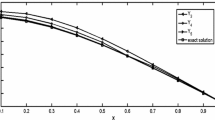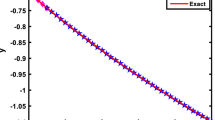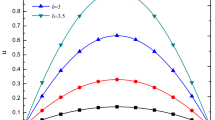Abstract
In this paper, we consider the following class of singular two-point boundary value problem posed on the interval x 𝜖 (0, 1]
A recursive scheme is developed, and its convergence properties are studied. Further, the error estimation of the method is discussed. The proposed scheme is based on the integral equation formalism and optimal homotopy analysis method in which a recursive scheme is established without any undetermined coefficients. The original differential equation is transformed into an equivalent integral equation to remove the singularity. The integral equation is then made free of undetermined coefficients by imposing the boundary conditions on it. Finally, the integral equation without any undetermined coefficients is efficiently treated by using optimal homotopy analysis method for finding the numerical solution. The optimal control-convergence parameter involved in the components of the series solution is obtained by minimizing the squared residual error equation. The present method is applied to obtain numerical solution of singular boundary value problems arising in various physical models, and numerical results show the advantages of our method over the existing methods.
Similar content being viewed by others
References
Keller, J.B., Electrohydrodynamics, I.: The equilibrium of a charged gas in a container. J. Rational Mech. Anal. 5, 715–724 (1956)
Chambre, P.L.: On the solution of the Poisson-Boltzmann equation with the application to the theory of thermal explosions. J. Chem. Phys. 20, 1795–1797 (1952)
Parter, S.V.: Numerical methods for generalised axially symmetric potentials. SIAM J., Ser. B 2, 500–516 (1965)
Ames, W.F.: Nonlinear ordinary differential equations in transport process. Academia Press, New York (1968)
Thomas, L.: The calculation of atomic fields. In: Mathematical Proceedings of the Cambridge Philosophical Society, Cambridge University Press, vol. 23, pp 542–548 (1927)
Fermi, E.: Un metodo statistio per la determinazione di alcune priorieta dell’atome. Rendicondi Accademia Nazionale de Lincei 32, 602–607 (1927)
McElwain, D.L.S.: A re-examination of oxygen diffusion in a spherical cell with Michaelis–Menten oxygen uptake kinetics. J. Theoret. Biol. 71, 255–263 (1978)
Lin, H.S.: Oxygen diffusion in a spherical cell with nonlinear oxygen uptake kinetics. J. Theoretical. Biol. 60, 449–457 (1976)
Flesch, U.: The distribution of heat sources in the human head: a theoretical consideration. J. Theoret. Biol. 54, 285–287 (1975)
Gray, B.F.: The distribution of heat sources in the human head: a theoretical consideration. J. Theoret. Biol. 82, 473–476 (1980)
Adam, J.A.: A simplified mathematical model of tumor growth. Math. Biosci. 81, 224–229 (1986)
Adam, J.A.: A mathematical model of tumor growth II: effect of geometry and spatial nonuniformity on stability. Math. Biosci. 86, 183–211 (1987)
Adam, J.A., Maggelakis, S.A.: Mathematical model of tumor growth IV: effect of necrotic core. Math. Biosci. 97, 121–136 (1989)
Burton, A.C.: Rate of growth of solid tumor as a problem of diffusion. Growth 30, 157–176 (1966)
Greenspan, H.P.: Models for the growth of solid tumor as a problem by diffusion. Stud. Appl. Math. 52, 317–340 (1972)
Nayfeh, A.H.: Perturbation methods. Wiley, New York (2000)
He, J.H.: Variational iteration method: a kind of nonlinear analytic technique: some examples. Int. J. Nonlinear Mech. 34, 699–708 (1999)
He, J.H.: Approximate analytical solution for seepage flow with fractional derivative with porous media. Comput. Meth. Appl Mech. 167, 57–68 (1998)
Adomian, G.: Solving frontier problems of physics: the decomposition method. Kluwer Academic, Dordrecht (1994)
Liao, S.J.: The proposed homotopy analysis technique for the solution of nonlinear problems, Ph.D. Thesis. Sanghai Jiao Tong University, Shangai (1992)
Liao, S.J.: A kind of approximate solution technique which does not depend upon small parameters: a special example. Int. J. Nonlinear Mech. 30, 371–380 (1995)
Liao, S.J., Perturbation, Beyond: Introduction to the homotopy analysis method, Chapman and Hall. CRC Press, Boca Raton (2003)
Liao, S.J.: On the homotopy analysis method for nonlinear problems. Appl. Math. Comput. 147, 499–513 (2004)
Liao, S.J., Tan, Y.: A general approach to obtain series solutions of nonlinear differential equations. Stud. Appl. Math. 119, 297–354 (2007)
Liao, S.J.: Notes on the homotopy analysis method: some definitions and theorems. Commun. Nonlinear Sci. Numer. Simulat. 14(4), 983–997 (2009)
Liao, S.: An optimal homotopy anlysis approach for strongly nonlinear differential equations. Commun. Nonlinear Sci. Numer. Simulat. 15, 2003–2016 (2010)
Marinca, V., Herisanu, N.: Application of optimal homotopy asymptotic method for solving nonlinear equations arising in heat transfer. Int. Commun. Heat Mass Transfer 35, 1216–1224 (2008)
Pandey, R.K., Verma, A.K.: Existance-Uniqueness results for a class of singular boundary value problems arising in physiology. Nonlinear Anal. Real World Appl. 9, 40–52 (2008)
Caglar, H., Caglar, N., Ozer, M.: B-Spline solution of non-linear singular boundary value problems arising in physiology. Chaos, Solitions and Fractals 39, 1232–1237 (2009)
Iyengar, S.R.K., Jain, P.: Spline Finite Differnce Methods for singular two point Boundary Value problem. Numer. Math. 50, 363–376 (1987)
Ravi kant, A.S.V.: Cubic spline polynomial for non-linear singular two-point boundary value problem. Appl. Math. Comput. 189, 2017–2022 (2007)
Khuri, S.A., Sayfy, A.: A novel approach for the solution of a class of singular boundary value problems arising in physiology. Math. Comput. Model. 52, 626–636 (2010)
Pandey, R.K., Singh, A.K.: On the convergence of a finite difference method for a class of singular boundary value problems arising in physiology. J. Comp. Appl. Math 166, 553–564 (2004)
Ravi Kanth, A., Aruna, K.: He’s varitional iteration method for treating nonlinear singular boundary value problem. Comput. Math. Appl. 60(3), 821–829 (2010)
Roul, P., Warbhe, U.: New approach for solving a class of singular boundary value problem arising in various physical models. J. Math. Chem. 54, 1255–1285 (2016)
Adomian, G.: Solution of the Thomas-Fermi Equation. Appl. Math. Lett. 11, 131 (1998)
Acknowledgments
The authors thankfully acknowledge the financial support provided by the SERB, Department of science and Technology, New Delhi, India, in the form of project no. SB/S4/MS/877/2014. The authors are highly grateful to the referees for their constructive comments.
Author information
Authors and Affiliations
Corresponding author
Rights and permissions
About this article
Cite this article
Roul, P., Biswal, D. A new numerical approach for solving a class of singular two-point boundary value problems. Numer Algor 75, 531–552 (2017). https://doi.org/10.1007/s11075-016-0210-z
Received:
Accepted:
Published:
Issue Date:
DOI: https://doi.org/10.1007/s11075-016-0210-z




